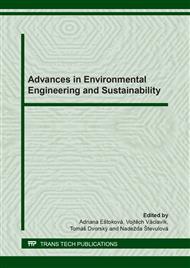[1]
R.R. Appannagari, Environmental Pollution Causes and Consequences: A Study, North Asian International Res. Jour. Soc. Sci. & Hum. 3 (2017).
Google Scholar
[2]
N. Junakova, M. Balintova, Model for predicting the nutrient content in reservoir bottom sediments, 11th International Multidisciplinary Scientific Geoconference and EXPO - Modern Management of Mine Producing, Geo. Envi. Prot. SGEM 2011, 3 (2011) 475-482.
DOI: 10.5593/sgem2011/s20.144
Google Scholar
[3]
N. Junakova, M. Balinova, Assessment of Nutrient Concentration in Reservoir Bottom Sediments, Proc. Eng. 42 (2012) 165-170.
DOI: 10.1016/j.proeng.2012.07.407
Google Scholar
[4]
N. Junakova, M. Balintova, Predicting Nutrient Loads in Chosen Catchment, Chem. Eng. Trans. 26 (2012) 591-596.
Google Scholar
[5]
C. Tundu, M.J. Tumbare, J.M.K. Onema, Sedimentation and Its Impacts/Effects on River Systemand Reservoir Water Quality: case study of Mazowe Catchment, Zimbabwe, Proc. IAHS 377 (2018) 57–66.
DOI: 10.5194/piahs-377-57-2018
Google Scholar
[6]
N. Junakova, M. Balintova, Predicting of soil loss in the Tisovec Catchment, Slovakia, Chem. Eng Trans. 28 (2012) 265-270.
Google Scholar
[7]
E. Singovszka, M. Balintova, N. Junakova, The effect of sediment grain size on heavy metal content in different depth in water reservoir Ruzin, Slovakia, Sol. sta. phen. 244 (2016) 240-245.
DOI: 10.4028/www.scientific.net/ssp.244.240
Google Scholar
[8]
E. Singovszka, M. Balintova, N. Junakova, Evaluation of surface water pollution in the Smolnik creek, 13th Int. Multid. Sci. Geocon. SGEM 2013, 1 (2013) 445-450.
DOI: 10.5593/sgem2013/be5.v1/s20.059
Google Scholar
[9]
M. Repčiak, Locality 6. Deposit Zlatá Baňa (polymetallic ores) in Slovak, Exkurzný sprievodca ku kongresu Slovenskej geologickej spoločnosti (in Slovak), Slovakia, Košice: CompuGraph, 2005, 102-108.
Google Scholar
[10]
N. Junakova, M. Balintova, Nutrient Leaching from Reservoir Bottom Sediments, Chem. Eng. Trans. 35 (2013) 1141-1146.
Google Scholar
[11]
J. Serra, P. González, S. Liste, C. Serra, S. Chiussi, B. León, M. Pérez-Amor, H.O. Ylänen, M. Hupa, FTIR and XPS studies of bioactive silica based glasses, J. of Non-Cryst. Sol. 332 (2003) 20-27.
DOI: 10.1016/j.jnoncrysol.2003.09.013
Google Scholar
[12]
Methodical Instruction (MI) of Ministry of Environment Slovak Republic No. 549/98-2 for the evaluation of risks from the contaminated sediment load of streams and reservoirs (in Slovak), Bratislava, Slovakia, (1998).
Google Scholar
[13]
Act No. 188/2003 of Code on application of sludge and river bed sediments on agricultural and forest soil (in Slovak), Bratislava, Slovakia, (2003).
Google Scholar
[14]
Regulation of the Government of the SR No. 269/2010, laying down the requirements for the achievement of good water status (in Slovak), Bratislava, Slovakia, (2010).
Google Scholar


